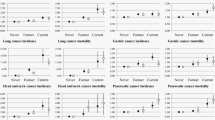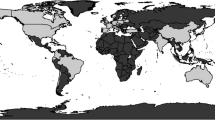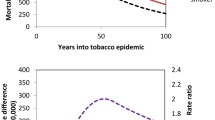Abstract
Background
Lung cancer risk is modified by smoking cessation. However, the inclusion in the group of former smokers of those who quit after developing symptoms or being diagnosed with lung cancer distorts the apparent risk in the first several years following cessation. This bias is termed the quitting ill effect.
Methods
Lung cancer mortality data from the American Cancer Society’s CPS-I were used to calculate the excess mortality among white male former smokers compared to the predicted risk had those individuals continued to smoke. Alternate approaches to minimizing the quitting ill bias were investigated. Goodness-of-fit of the models was assessed graphically and formally.
Results
Poisson models were built for the absolute lung cancer risk for never smokers and the excess risk, over never smokers, for continuing smokers. The decrease in excess risk in former smokers was modeled by a negative exponential function. The models for the three smoker subgroups (continuing, never, and former), all fit the data well. Assuming that the fraction of excess risk remaining for former smokers does not decline for the first two years following cessation and that the quitting ill effect does not influence those who are five or more years post-cessation allowed a reasonable estimation of the change in risk of lung cancer with increasing duration of abstinence.
Conclusions
The reduction in the excess risk of lung cancer in former smokers can be estimated, and the quitting ill effect minimized, by the inclusion of a lag between cessation and onset of reduction in risk.





Similar content being viewed by others
References
Ebbert JO, Yang P, Vachon CM, Vierkant RA, Cerhan JR, Folsom AR et al (2003) Lung cancer risk reduction after smoking cessation: observations from a prospective cohort of women. J Clin Oncol 21(5):921–926
Peto R, Darby S, Deo H, Silcocks P, Whitley E, Doll R (2000) Smoking, smoking cessation, and lung cancer in the UK since 1950: combination of national statistics with two case–control studies. BMJ 321(7257):323–329
Taylor DH Jr, Hasselblad V, Henley SJ, Thun MJ, Sloan FA (2002) Benefits of smoking cessation for longevity. Am J Public Health 92(6):990–996
Lubin JH, Blot WJ, Berrino F, Flamant R, Gillis CR, Kunze M et al (1984) Modifying risk of developing lung cancer by changing habits of cigarette smoking. Br Med J (Clin Res Ed) 288(6435):1953–1956
Garfinkel L, Stellman SD (1988) Smoking and lung cancer in women: findings in a prospective study. Cancer Res 48(23):6951–6955
Halpern MT, Gillespie BW, Warner KE (1993) Patterns of absolute risk of lung cancer mortality in former smokers. J Natl Cancer Inst 85(6):457–464
Thun MJ, Myers DG, Day-Lally C, Namboodiri MM, Calle EE, Flanders WD et al (1997) Age and the exposure-response relationships between cigarette smoking and premature death in Cancer Prevention Study II. In: Changes in cigarette-related disease risks and their implication for prevention and control: smoking and tobacco control monograph no. 8, U.S. Department of Health and Human Services, National Institutes of Health, National Cancer Institute. NIH Publication No. 97-4213
Garfinkel L (1985) Selection, follow-up, and analysis in the American Cancer Society prospective studies. Natl Cancer Inst Monogr 67:49–52
Breslow NE, Day NE (1987) Statistical methods in cancer research: the design and analysis of cohort studies. International Agency for Research on Cancer, Lyon
Flanders WD, Lally CA, Zhu BP, Henley SJ, Thun MJ (2003) Lung cancer mortality in relation to age, duration of smoking, and daily cigarette consumption: results from Cancer Prevention Study II. Cancer Res 63(19):6556–6562
Stoke ME, Davis CS, Koch GG (2000) Categorical data analysis using the SAS system, 2nd edn. SAS Institute Inc., Cary
Jennrich RI, Ralston ML (1979) Fitting nonlinear models to data. Annu Rev Biophys Bioeng 8:195–238
Cochran WG (1954) Some methods for strengthening the common chi-squared test. Biometrics 10:417–451
Knoke JD, Shanks TG, Vaughn JW, Thun MJ, Burns DM (2004) Lung cancer mortality is related to age in addition to duration and intensity of cigarette smoking: an analysis of CPS-I data. Cancer Epidemiol Biomarkers Prev 13(6):949–957
Doll R, Peto R (1978) Cigarette smoking and bronchial carcinoma: dose and time relationships among regular smokers and lifelong non-smokers. J Epidemiol Commun Health 32(4):303–313
Freedman DA, Navidi WC (1990) Ex-smokers and the multistage model for lung cancer. Epidemiology 1(1):21–29
Bach PB, Kattan MW, Thornquist MD, Kris MG, Tate RC, Barnett MJ et al (2003) Variations in lung cancer risk among smokers. J Natl Cancer Inst 95(6):470–478
Thun MJ, Day-Lally C, Meyers DG, Calle EE, Flanders WD, Zhu B-P et al (1997) Trends in tobacco smoking and mortality from cigarette use in cancer prevention studies I (1959 through 1965) and II (1982 through 1988). In: Changes in cigarette-related disease risks and their implication for prevention and control: smoking and tobacco control monograph no. 8, U.S. Department of Health and Human Services, National Institutes of Health, National Cancer Institute. NIH Publication No. 97-4213
Thun MJ, Henley SJ, Burns D, Jemal A, Shanks TG, Calle EE (2006) Lung cancer death rates in lifelong nonsmokers. J Natl Cancer Inst 98(10):691–699
Acknowledgment
The authors thank Jerry W. Vaughn for supplying the Excel file, which creates the interactive figure.
Author information
Authors and Affiliations
Corresponding author
Appendix
Appendix
Rights and permissions
About this article
Cite this article
Knoke, J.D., Burns, D.M. & Thun, M.J. The change in excess risk of lung cancer attributable to smoking following smoking cessation: an examination of different analytic approaches using CPS-I data. Cancer Causes Control 19, 207–219 (2008). https://doi.org/10.1007/s10552-007-9086-5
Received:
Accepted:
Published:
Issue Date:
DOI: https://doi.org/10.1007/s10552-007-9086-5




